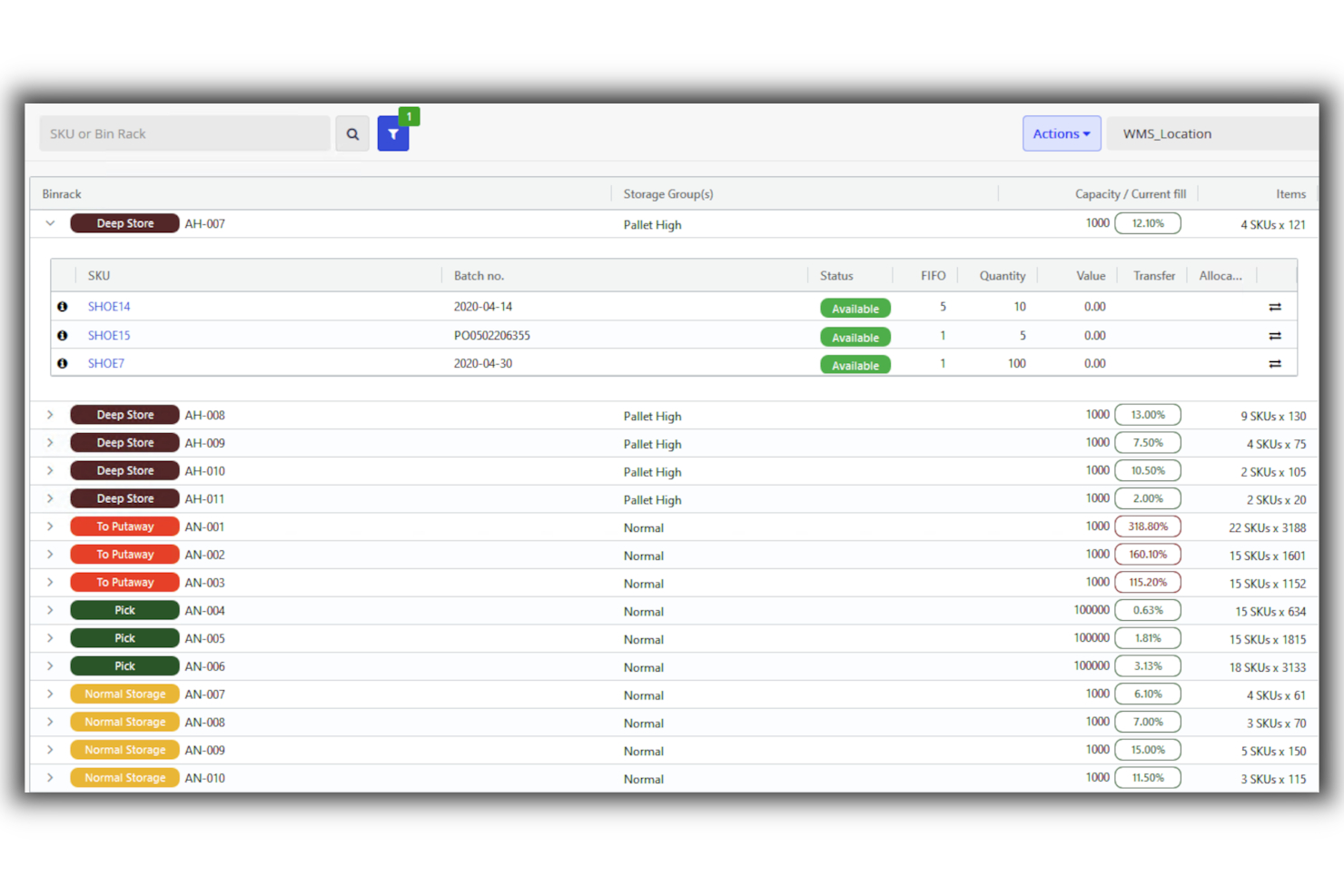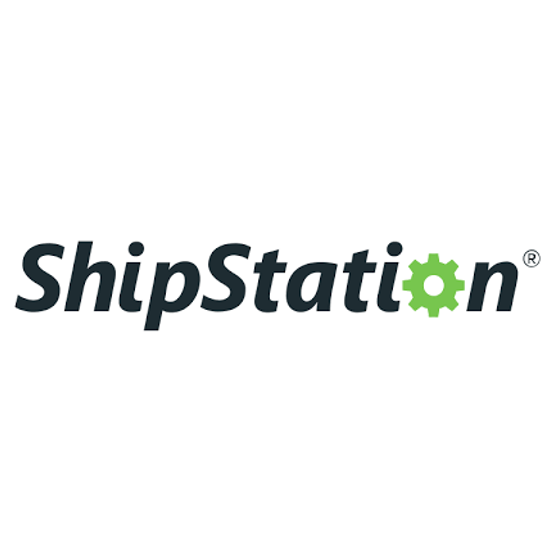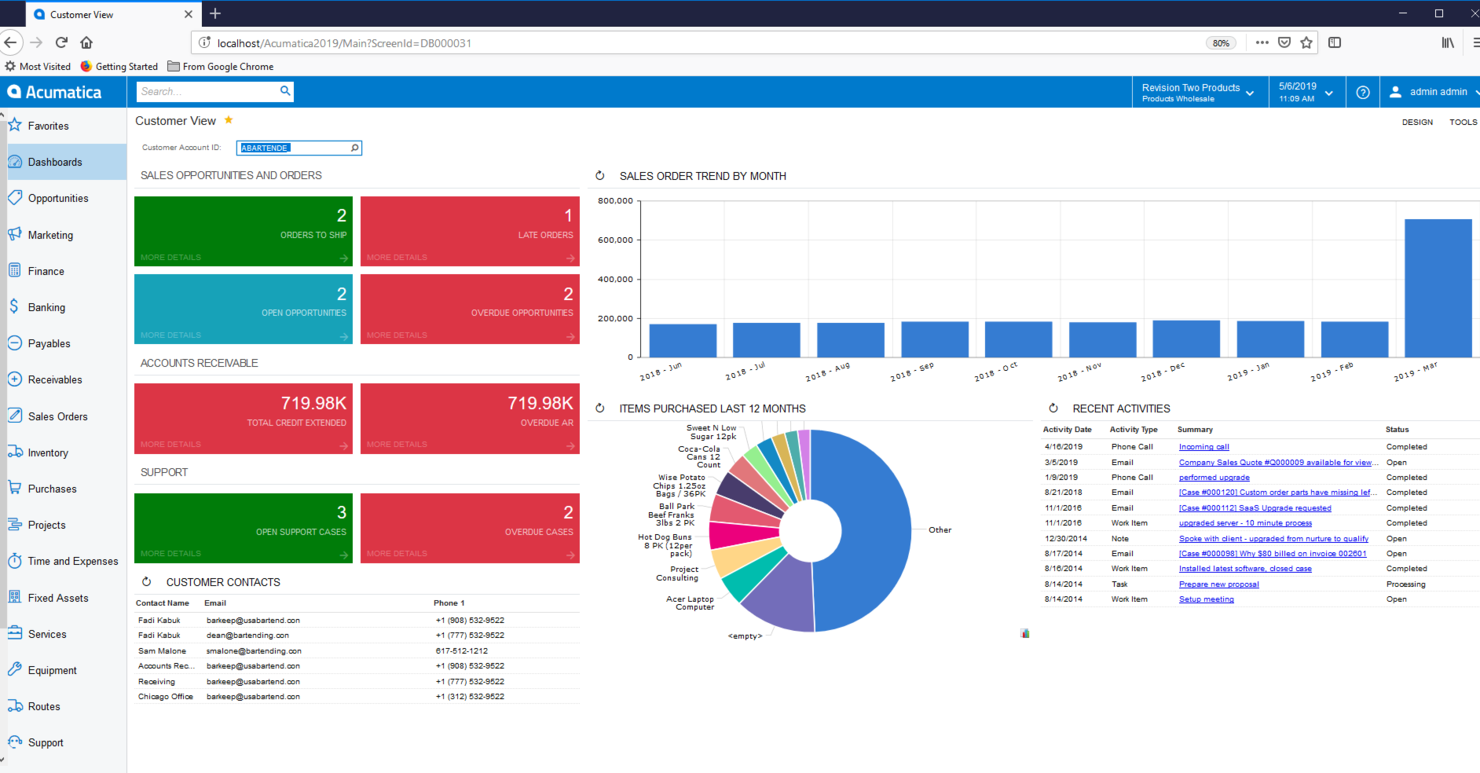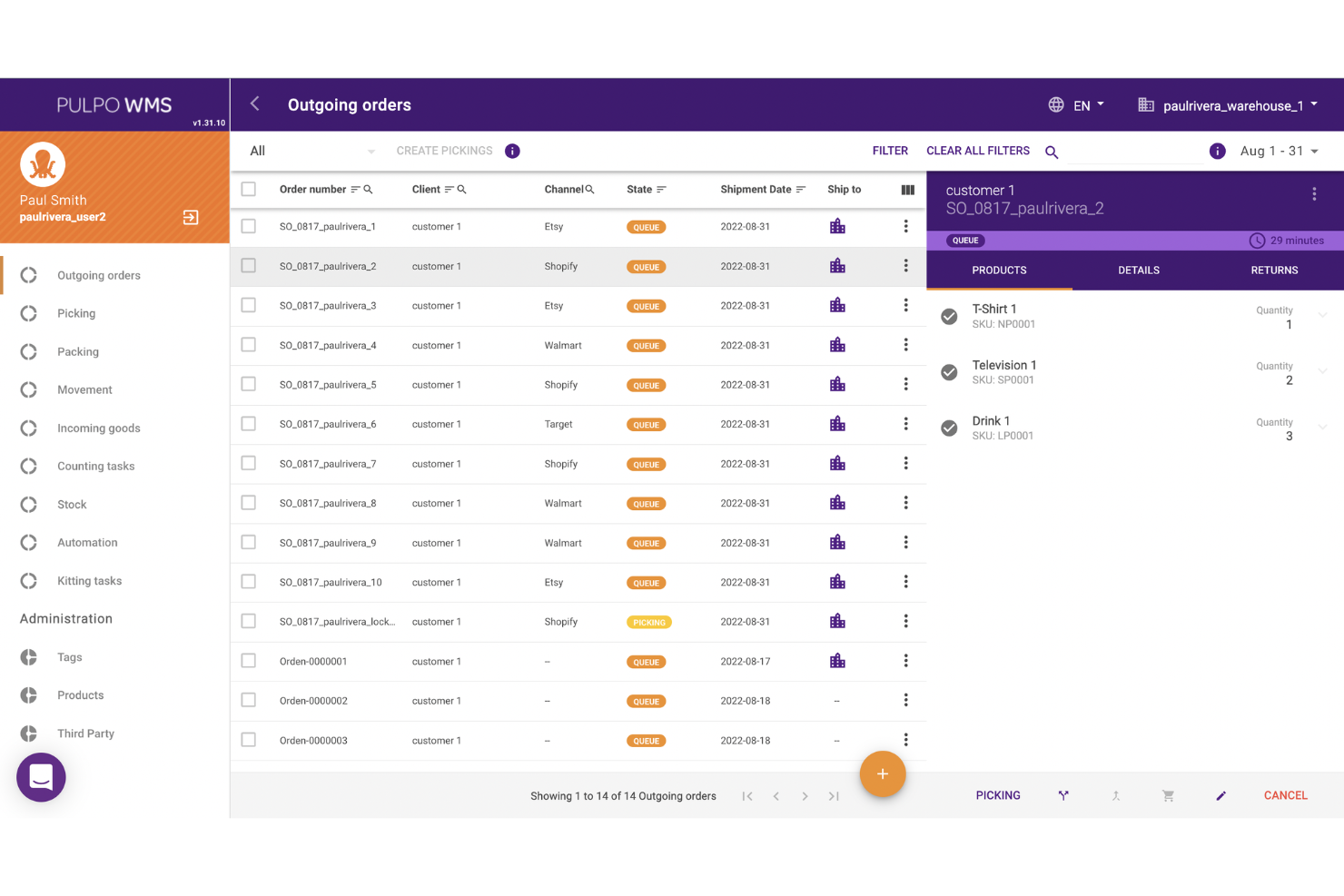10 Best Warehouse Management Software Shortlist
Here's my pick of the 10 best software from the 25 tools reviewed.
Our one-on-one guidance will help you find the perfect fit.
There are seemingly countless warehouse management software solutions available, so figuring out which is best for you is tough. You want to optimize and streamline warehouse operations but need to figure out which tool is the best fit. I've got you! In this post, I make things simple, leveraging my experience as an ecommerce specialist using dozens of different warehouse management tools to bring you this shortlist of the best warehouse management software overall.
Why Trust Our Warehouse Management Software Reviews
We’ve been testing and reviewing ecommerce software since 2022. As marketers ourselves, we know how critical, and difficult it is to make the right decision when selecting software.
We invest in deep research to help our audience make better software purchasing decisions. We’ve tested more than 2,000 tools for different ecommerce use cases and written over 1,000 comprehensive software reviews. Learn how we stay transparent & our review methodology.
The Best Warehouse Management Software Pricing Comparison Chart
Find all the tools that we just covered in the overviews, side by side.
| Tools | Price | |
|---|---|---|
| SkuVault | From $359/month | Website |
| Linnworks | From $449/month (volume-based pricing) | Website |
| ShipStation | From $9.99/month | Website |
| SphereWMS | Pricing available upon request | Website |
| Cin7 Core | From $349/month | Website |
| Cadence WMS | Pricing upon request | Website |
| ShipBob | Pricing upon request | Website |
| NetSuite | Pricing upon request | Website |
| Acumatica Cloud ERP | Pricing upon request | Website |
| PULPO WMS | From $50/month | Website |
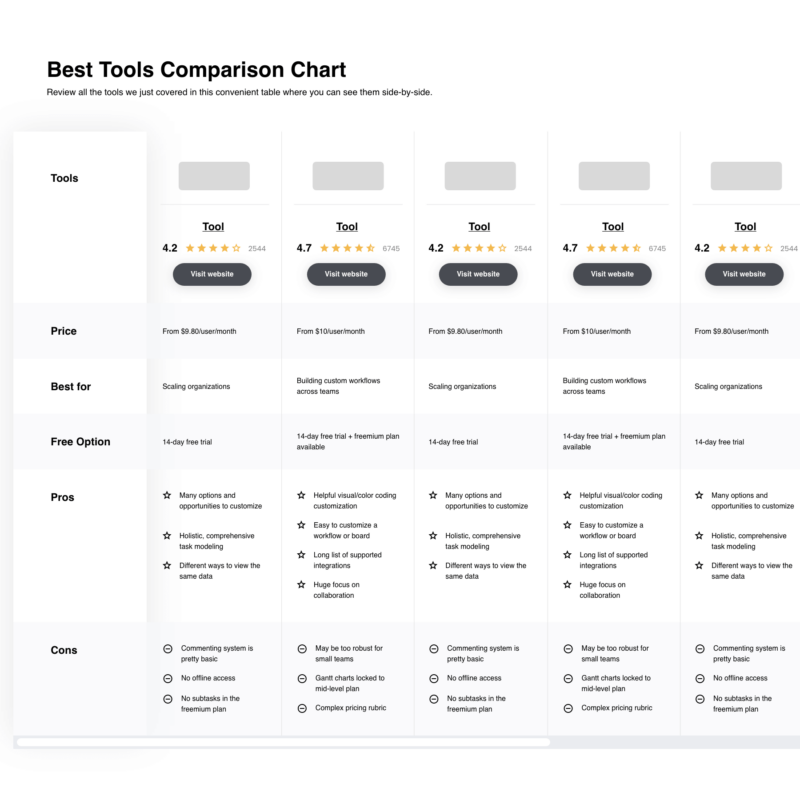
Compare Software Specs Side by Side
Use our comparison chart to review and evaluate software specs side-by-side.
Compare SoftwareHow to Choose Warehouse Management Software
With so many different warehouse management software solutions available, it can be challenging to make decisions on what warehouse management software is going to be the best fit for your needs.
As you're shortlisting, trialing and selecting warehouse management software, consider:
- What you want to use it to do - Start by identifying the warehouse management software feature gap you're trying to fill to clarify the features and functionality the warehouse management platform needs to provide.
- Who will need to use it - To evaluate cost and requirements, consider who'll be using the software and how many licenses you'll need. You'll need to evaluate if it'll just be ecommerce professionals, or the whole organization that will require access. When that's clear, it's worth considering if you're prioritizing ease of use for all, or speed for your warehouse management software power users.
- What other tools it needs to work with - Clarify what tools you're replacing, what tools are staying, and the tools you'll need to integrate with, such as accounting, CRM, or project management software. You'll need to decide if the tools will need to integrate together, or alternatively, if you can replace multiple tools with one consolidated warehouse management solution.
- What outcomes are important - Consider the result that the software needs to deliver to be considered a success. Consider what capability you want to gain, or what you want to improve, and how you will be measuring success. For example, an outcome could be the ability to get greater visibility into performance. You could compare warehouse management software features until you’re blue in the face but if you aren’t thinking about the outcomes you want to drive, you could be wasting a lot of valuable time.
- How it would work within your organization - Consider the software selection alongside your workflows and delivery methodology. Evaluate what's working well, and the areas that are causing issues that need to be addressed. Remember every business is different—don’t assume that because a tool is popular that it'll work in your organization.
Best Warehouse Management Software Reviews
Here’s an evaluation of the 10 best warehouse management software.
SkuVault is an eCommerce inventory management software that helps you connect channels, organize warehouses, and manage inventory efficiently.
Why I picked SkuVault: One of the things SkuVault excels at is the sheer number of ready-to-go integrations they have available with their system, a selection of which is listed below. I also like the focus it has on your customers. Its pick, pack, and ship features help you streamline your processes, so your clients get their orders on time.
The features that support this customer focus are interactive wave picking, holds, daily deals, flash sales, print-to-order, and their own HyperPicking, which tells you exactly what you need to pick to fulfill an order and when.
SkuVault Standout Features & Integrations
Features include inventory forecasting, real-time data syncs, inventory picking and quality control, advanced analytics, and insights into your warehouse.
Integrations include 3dcart, Amazon, Anvizent, Back Market, Big Commerce, eBay, Ecomitize, Etsy, Feedonomics, GeekSeller, InfoCon Systems, Jet, Logic Broker, Magento, Microsoft Dynamics, Miva, Mozu, Oracle Netsuite, Quickbooks, Salesforce, RetailPro, Sellbrite, ShipRush, Shopify, Square, WooCommerce, Zero, and many more.
SkuVault Plans & Pricing
Pricing starts at $329/month and has a free demo.
Linnworks is a cloud-based software that helps sellers manage inventory and automate order fulfillment across multiple channels. It eliminates the need to enter data manually, streamlining the process of picking, packing, and shipping orders. Its features include centralized inventory management, order tracking, and automation.
Why I Picked Linnworks: Linnworks is compatible with many marketplaces and courier services. It provides real-time inventory management, alerts when stocks are low, and generates reports that help make data-driven decisions. Users can easily manage stock levels with real-time updates, automated price updates, and easy stock notifications. Beyond inventory management, Linnworks provides a platform for seamless sales channel integration. Sellers can connect their online stores, marketplaces, and shipping carriers, ensuring all sales channels push and pull data from the same central hub.
Sellers can create and print shipping labels, generate packing slips, and automatically update order status. Linnworks helps streamline the shipping process by allowing users to choose from various shipping carriers and services, such as Royal Mail, DPD, and UPS. It provides valuable reporting and analytical tools that help track performance. Merchants can access orders, inventory, and sales data across different channels. Customizable dashboards and in-depth reports help track key performance metrics, identify operational bottlenecks, and forecast future trends.
Linnworks Standout Features & Integrations
Features include API, dashboards, data export/data import, data visualization, external integrations, forecasting, inventory tracking, multi-user, notifications, supplier management, product catalog, shipping management, order management, status notifications, and warehouse management.
Integrations include Amazon, Magento, eBay, Shopify, BigCommerce, Walmart, Buy on Google, Wish, TikTok Shops, WooCommerce, Quickbooks, Gorgias, Payoneer, and others.
Linnworks Pricing & Plans
Linnworks offers pricing upon request, as well as a free demo.
ShipStation is an ecommerce shipping solution that offers a range of features to help businesses manage and streamline their shipping processes.
Why I picked ShipStation: After comparing several options, I determined that ShipStation stood out due to its ability to streamline ecommerce shipping processes effectively. The platform provides access to discounted postage rates from top carriers, such as USPS, UPS, FedEx, and DHL. The platform also provides tools for batch order creation, automated actions, and real-time tracking, allowing for efficient order fulfillment. With branding services, inventory management tools, and integrations with marketplaces and shopping carts, ShipStation offers a comprehensive solution for ecommerce shipping needs.
ShipStation Standout Features & Integrations
Features include automation and batching. Automation enables users to automate repetitive tasks and batch process orders. Users can create automation rules to automatically apply shipping settings, assign tags, and send notifications. Batching allows users to process multiple orders at once, saving time and improving efficiency.
Integrations include over 300 options, including Squarespace, Ebay, Walmart, Shopify, Etsy, Wix, Klaviyo, Square, bigcartel, Quickbooks, and Morecommerce.
ShipStation Plans & Pricing
ShipStation offers different pricing plans starting at $9.99 per month.
SphereWMS’ warehouse management software allows you to gain control, efficiency, and visibility over your warehouse operations.
Why I picked SphereWMS: The software keeps tabs on your inventory, no matter if it's sitting in a warehouse, incoming, or outgoing. It also has the capacity to manage multi-client and multi-warehouse facilities.
One thing I particularly like is its capacity to streamline the receiving process and how it goes from your shipping dock to your storage location. This includes support for ARN, including file upload, receipt info entry, putaway entry, label print, ASN entry, and confirmation notifications.
SphereWMS Standout Features & Integrations
Features include real-time web visibility and reporting, parcel shipping, inventory management, order fulfillment, retail EDI, and a multi-platform mobile app.
Integrations are available with top e-commerce sites and online shopping carts. Integration options include Amazon, ApparelMagic, BigCommerce, Blue Cherry, Channel Advisor, ClickFunnels, CS.cart, Etsy, Foxycart, Houzz, Joor, Netsuite, PayPal, PrestaShop, Salesforce, Squarespace, WooCommerce, and more.
SphereWMS Plans & Pricing
Pricing and demo are available upon request
Cin7 Core is an ecommerce management tool that specializes in streamlined inventory management. By focusing on the core aspects of inventory management, Cin7 Core ensures that businesses can effectively track, monitor, and control their inventory levels, leading to improved operational efficiency and cost savings.
Why I chose Cin7 Core: I chose it for this list because it provides features for barcode scanning, pick and pack workflows, and inventory location tracking. It helps businesses optimize warehouse operations, improve order fulfillment accuracy, and reduce picking errors. On top of that, its warehouse management capabilities allow you to bring shipping and back-end warehouse together so you can receive, process, and ship orders using one tool.
The system also offers additional tools such as point of sale, B2B portals, and robust reporting, providing a complete solution for businesses.
Cin7 Core Standout Features & Integrations
Features include a dedicated warehouse management mobile app so you can control your inventory while away from your desk. I also like its guided walk paths and wave-based picking which can help you save walking time and therefore reduce fulfillment time.
Integrations include accounting software and other platforms, including Shopify, Quickbooks, Amazon, and Xero. Additionally, it has developer APIs you can use to build custom integrations with your current tech stack. Integrations with 3PL and EDI systems are available for when you need to scale.
Cin7 Core Plans & Pricing
The tool offers 4 pricing tiers that start at $349 per month. If you want to try it our, there is a 14-day free trial you can access through the website.
Cadence WMS is a dynamic, real-time Warehouse Management System designed for distributors, third-party logistics companies, and manufacturers. It efficiently organizes inventory, orders, shipments, and workflows, catering to a variety of complex logistics business models and product verticals.
Why I Picked Cadence WMS: Cadence WMS stands out with its ability to be tailored to specific industry needs. This includes tracking unique requirements such as expiration dates, temperature control, and picking priorities (like LIFO, FIFO). This level of customization is particularly beneficial for industries with specialized needs, such as consumer products, food and beverage, frozen foods, electronics, automotive parts, and pharmaceuticals. The system's adaptability to handle environmental factors, serialization, high-value items, and more, makes it a versatile choice for a wide range of sectors.
Cadence WMS excels in high-volume, multi-channel fulfillment distribution. It is designed to match inventory with orders across various distribution channels, including pallets for distribution centers, cases or cartons for retail stores, and parcels for consumers. This feature is especially important for businesses that operate across multiple sales channels and need a WMS that can efficiently handle diverse order types and distribution methods. The system's ability to span inbound orders and inventory, along with various warehouse operations, makes it a robust solution for omni-channel logistics.
Cadence WMS Standout Features & Integrations
Features include real-time inventory tracking, order management, warehouse optimization, barcode scanning, automated data collection, integration with ERP systems, customizable reporting, multi-warehouse support, labor management, cross-docking, quality control, and returns processing.
Integrations include Microsoft Dynamics, QuickBooks, Sage, NetSuite, UPS, FedEx, DHL, regional LTL carriers, Shopify, Magento, WooCommerce, automation technologies (including robotics, conveyor systems, automated storage and retrieval systems), and advanced API integration.
Pros and cons
Pros:
- Comprehensive feature set
- Integration with ecommerce platforms
- Includes warehouse optimization features
Cons:
- Slight learning curve
- May be cost prohibitive for small biz
ShipBob is a cloud-based WMS that provides ecommerce businesses with an end-to-end solution for managing inventory, orders, and fulfillment. It has a network of fulfillment centers across the US, Canada, and Europe, enabling fast and affordable shipping to customers in these regions.
Why I Picked ShipBob: ShipBob offers a variety of shipping and delivery options, including same-day, two-day, and overnight shipping. The platform allows businesses to choose the most cost-effective shipping options for their products while ensuring timely delivery to customers. ShipBob automates the distribution process with minimal manual intervention. It enables the monitoring of stock levels, providing real-time alerts when inventory thresholds are exceeded.
Businesses can keep track of their inventory across all sales channels in real time, allowing them to know when it’s time to reorder products to avoid stockouts. The system alerts users when their inventory runs low so that they can replenish it in time. ShipBob’s order kitting and assembly feature speeds up the fulfillment process. This feature lets users group multiple items into one package, reducing the number of individual line items to process. This feature benefits companies that offer various products with unique SKUs.
ShipBob's advanced reporting and analytics feature makes it easy for companies to track their performance. With real-time data on their inventory, order status, and shipping information, merchants can optimize their warehouse operations and make data-driven decisions. The system generates reports for critical metrics, such as order volume, fulfillment time, and shipping costs, so they can analyze their performance and find areas for improvement.
ShipBob Standout Features & Integrations
Features include dashboards, data export/data import, data visualization, external integrations, inventory tracking, multi-user, notifications, product catalog, shipping management, API access, and order management
Integrations include Shopify, Amazon, BigCommerce, Magento, Squarespace, Square, Walmart, Wix, and WooCommerce.
ShipBob Plans & Pricing
ShipBob offers pricing upon request. You can ask them for a free demo.
NetSuite is a cloud-based ERP business software solution that combines financial, cash flow, payroll, inventory, and more into one tool, so users have clear visibility and total control of their business.
Why I picked NetSuite: The software uses industry-leading practices, like task management, cycle count plans, RF barcode scanning, and specific strategies for picking and putting away. Further, NetSuite has a mobile version of its software where warehouse personnel can be prompted to do activities like receiving, shipping, picking items, and storing them.
Finally, the system connects with your inventory, order fulfillment, and manufacturing systems and updates information in real time across your company.
NetSuite Standout Features & Integrations
Features include inventory visibility, analytics on fill rates and accuracy, inbound logistics, order fulfillment, mobile warehouse management, bin management, and cycle counts.
Integrations include Oracle, JD Edwards EnterpriseOne, Sage Business, Affirm, NetSuite CRM, Lightyear, ZoneBilling, Neuron ESB, and Pacejet.
NetSuite Plans & Pricing
Pricing is available upon request. You will need to buy the NetSuite core platform, plus the WMS module. Oracle offers a free product tour.
Acumatica is a warehouse management system that streamlines warehouse operations and transactions to reduce errors, automate processes, and increase productivity. The software can help reduce errors, increase customer satisfaction, automate data capture and processing, simplify the product tracking process, and allow for prioritized and directed picking.
Why I picked Acumatica: This warehouse management system extends the capabilities of order management and inventory management by implementing barcode scanning for warehouse floor data collection and inventory transactions. The efficient barcode scanning and authentication, in particular, help avoid mistakes in order fulfillment. It also helps eliminate over- and under-shipments, as well as the all-too-common mistake of shipping the wrong items to the customer.
Additionally, the system can automate the data capture process to minimize errors. It automates the PO receiving, routine picking, packaging, transferring, putting away, and physical counting tasks and processes by leveraging custom-built workflows and form modes. Another great feature is warehouse operations monitoring—it provides personalized dashboards, timely alerts, and easy-to-understand data visualizations to help you keep track of your day-to-day warehouse operations.
Acumatica Standout Features & Integrations
Features include pick lists and packing slip generation, automated shipment tracking, customer fulfillment notifications, real-time dashboards, and inventory insights.
Integrations include tools like EazyStock, WorkforceGO, Celigo, Pacejet, Shopify, Adobe Sign, and hundreds more.
Acumatica Plans & Pricing
Pricing varies based on the modules used per plan and requires a custom quote.
PULPO WMS is a cloud-based warehouse management system that provides businesses with real-time visibility and control over their inventory and logistics operations.
Why I Picked PULPO WMS: PULPO WMS helps with ecommerce warehouse management by providing businesses with a centralized platform to manage and optimize their warehouse operations. The system offers real-time inventory tracking, order fulfillment management, and shipping and receiving management, enabling ecommerce businesses to efficiently manage their inventory and fulfill orders on time. PULPO WMS also offers advanced reporting and analytics tools that enable businesses to identify trends and optimize their inventory levels, reducing the risk of overstocking or stockouts. Additionally, the system offers integrations with leading ecommerce platforms and shipping carriers, allowing businesses to automate their order fulfillment and shipping processes, streamline their operations, and provide a better customer experience.
PULPO WMS excels in providing a user-friendly and customizable warehouse management system that offers real-time inventory tracking and optimization, advanced reporting and analytics, and seamless integrations with leading ecommerce platforms and shipping carriers. PULPO WMS's customer support and training resources are highly rated by customers, boasting high levels of responsiveness and expertise of the PULPO WMS support team.
PULPO WMS Standout Features & Integrations
Features include inventory tracking, inventory optimization, order fulfillment, shipping & receiving, barcode scanning, label printing, reporting & analytics, customizable workflows, user permissions, third-party integrations, mobile accessibility, multi-location support, customer support, and training resources.
Integrations include Shopify, WooCommerce, Magento, Sendcloud, Odoo and others.
PULPO WMS Plans & Pricing
Pricing is available upon request. You can book a free demo and take a freeproduct tour on PULPO’s website.
Other Warehouse Management Software
These are the rest of my selections for the best warehouse management software.
- Infoplus
Best for automated routing
- Manhattan WMS
Best for AI-powered supply chain management
- Hopstack
Best for managing and executing a complete order fulfillment lifecycle
- Blue Link ERP
Best for wholesalers and distributors
- Odoo Inventory
Best open source warehouse management software
- mobe3 WMS
Best for optimizing warehouse layout & picking routes
- IRMS360
Best configurable dashboards
- Highjump
Best for warehouse automations
- TradeGecko
Bets QuickBooks inventory integration
- Agiliron
Best for CRM integration
- Zoho Inventory
Best for ease of use
- Fishbowl Warehouse
Best for automated inventory purchasing
- Tecsys
Best for scalability
- Shipedge
Best for kitting and manufacturing
Related Ecommerce Software Reviews
If you still haven't found what you're looking for here, check out these tools related to warehouse management software that we've tested and evaluated.
- Ecommerce Platforms
- Inventory Management Software
- Payment Processing Software
- Shopping Cart Solutions
- Order Management Systems
Selection Criteria for Warehouse Management Software
Selecting the right warehouse management software (WMS) is pivotal for businesses aiming to enhance their warehouse operations' efficiency and accuracy. Through hands-on trials and comprehensive research, I've crafted a set of criteria that align with the specific needs, pain points, and operational goals of businesses seeking to optimize their warehouse operations.
Core Warehouse Management Software Functionality - 25% of total weighting score
To be considered for inclusion on my list of the best Warehouse Management Software, the solution had to support the ability to fulfill common use cases:
- Real-time inventory tracking and management across multiple warehouse locations.
- Efficient processing of receiving, putaway, picking, and shipping operations.
- Seamless integration with barcode scanners and RFID technology for inventory accuracy.
- Comprehensive order management from receipt to fulfillment.
- Detailed reporting and analytics for actionable insights into warehouse operations.
Additional Standout Features - 25% of total weighting score
Identifying software that offers unique features not provided by the competition involved looking for:
- Advanced AI and machine learning capabilities for predictive analytics and demand forecasting.
- Robust support for complex warehouse operations such as cross-docking and wave picking.
- Integration with drones or automated guided vehicles (AGVs) for inventory counts and surveillance.
- Customizable dashboards and user interfaces tailored to various roles within the warehouse.
- Environmental sustainability features, such as optimized routes within the warehouse to reduce energy consumption.
Usability - 10% of total weighting score
When evaluating usability, key considerations included:
- An intuitive user interface that simplifies complex warehouse operations.
- Customizable workflows that can be tailored to match specific operational processes.
- Mobile compatibility, allowing staff to access the system from handheld devices on the warehouse floor.
Onboarding - 10% of total weighting score
For onboarding, essential aspects were:
- Comprehensive training materials, including videos, documentation, and live webinars.
- Interactive onboarding experiences, such as product tours that guide users through key features.
- Responsive support teams available to assist with setup and customization.
Customer Support - 10% of total weighting score
Effective customer support was assessed by:
- Multi-channel support options, including phone, email, live chat, and a knowledge base.
- Availability of a dedicated account manager for personalized assistance.
- A community forum or user group for peer advice and best practices sharing.
Value For Money - 10% of total weighting score
Assessing value for money involved looking at:
- Transparent pricing models that clearly outline the features and support included at each price point.
- Flexibility in pricing plans to accommodate businesses of different sizes and needs.
- The inclusion of critical features in the base price, minimizing the need for expensive add-ons.
Customer Reviews - 10% of total weighting score
In evaluating customer reviews, focus was placed on:
- Positive feedback regarding the system's impact on warehouse efficiency and inventory accuracy.
- User testimonials highlighting the software's ease of use and customer support quality.
- Case studies demonstrating successful implementation and tangible benefits realized by users.
This criteria framework ensures that the selected Warehouse Management Software not only covers the foundational needs for efficient warehouse operations but also stands out with innovative features that can significantly enhance operational efficiency, provide a superior user experience, and offer great value for the investment.
Trends in Warehouse Management Software for 2024
Advancements in warehouse management software (WMS) are setting new benchmarks for how ecommerce warehouses operate, manage inventory, and fulfill orders. Based on the latest product updates, press releases, and release logs from the industry's leading tools, here's what I've discovered about the evolving landscape of warehouse management technology:
- Integration with Advanced Technologies: There's a clear trend towards the integration of WMS with cutting-edge technologies such as IoT (Internet of Things), AI (Artificial Intelligence), and robotics. Tools like SmartWMS have introduced features for real-time inventory tracking using IoT devices, while FlexiWare Solutions now offer AI-driven forecasting and robotics process automation for picking and packing processes. This integration enhances real-time decision-making and operational efficiency.
- Augmented Reality (AR) for Warehouse Operations: Some of the most novel features come from the integration of AR into WMS. VisionPick has introduced AR-guided picking, which overlays digital picking lists onto the real-world environment, drastically reducing errors and improving picking speed.
- Sustainability Features: With an increasing focus on sustainability, features aimed at reducing waste and optimizing resource use are becoming more common. EcoWare Manager now includes modules for calculating carbon footprint and suggesting routes and processes that minimize environmental impact.
What is Warehouse Management Software?
Warehouse management software is a digital tool designed to optimize warehouse operations. It manages inventory, tracks goods movement, and coordinates order processing and shipping. This software streamlines tasks like picking, packing, and restocking, and provides real-time data for better decision-making. The purpose is to enhance efficiency, reduce errors, and improve customer service, making warehouse operations more effective and responsive to market demands.
Features of Warehouse Management Software
Beyond the core functionalities, here are some additional key features I kept an eye out for in my research:
- Order Fulfillment: Creating pick lists, managing distributors, shipping orders, managing various sales channels, and purchase order management.
- Inventory Management: Provides real-time data on inventory levels, locations, and statuses, enabling accurate tracking of goods through RFID, barcodes, or QR codes. This feature helps in maintaining optimal inventory levels and reducing the risk of overstocking or stockouts.
- Receiving and Putaway: Assists in the efficient handling of goods as they arrive at the warehouse, including inspection, labeling, and proper storage. Automated putaway features suggest the best locations for items based on space, movement frequency, and picking efficiency.
- Picking and Packing: Streamlines the picking process by guiding warehouse staff to the correct storage locations, optimizing picking routes, and suggesting packing methods. Some systems integrate with automated picking solutions to further increase efficiency.
- Shipping and Transportation Management: Coordinates the shipping process, including carrier selection, shipping label generation, and route planning. This feature often integrates with carriers to provide real-time shipping rates and tracking information.
- Labor Management: Monitors warehouse staff performance, tracks labor costs, and identifies areas for improvement. This feature helps in optimizing workforce allocation and increasing productivity.
- Reporting and Analytics: Offers detailed reports and analytics on various aspects of warehouse operations, such as inventory levels, order fulfillment rates, and worker productivity. These insights support strategic decision-making and operational improvements.
- Integration Capabilities: Seamlessly integrates with other systems such as ERP (Enterprise Resource Planning), CRM (Customer Relationship Management), and e-commerce platforms. This ensures data consistency across systems and enhances operational efficiency.
- Quality Management: Includes features for quality control checks and returns processing, ensuring that products meet quality standards and that customer returns are handled efficiently.
- Workflow Management: Managing and automating parts or all of your warehousing processes, like the putaway process, slotting, or cycle counting process.
- Yard and Dock Management: Manages the movement of vehicles and goods in the warehouse yard and loading docks, optimizing the flow of inbound and outbound goods.
- Security and Compliance: Ensures data security through user access controls and activity logs. It also helps in complying with industry regulations and standards related to inventory management and shipping.
- Mobile Accessibility: Offers mobile applications or mobile-friendly interfaces that allow staff to access the system and perform tasks directly from the warehouse floor, improving efficiency and data accuracy.
Benefits of Warehouse Management Software
By automating and streamlining processes, WMS solutions provide users and organizations with powerful tools to manage inventory, orders, and overall warehouse logistics more effectively. Here are five primary benefits of implementing warehouse management software:
- Increased Operational Efficiency: WMS automates many of the manual tasks associated with warehouse operations, from inventory tracking to order fulfillment. This automation reduces the time and labor required for these processes, enabling faster, more efficient operations.
- Enhanced Inventory Accuracy: By providing real-time inventory tracking and updates, WMS significantly reduces the chances of errors in inventory counts. This accuracy ensures that businesses can maintain optimal inventory levels, reducing both overstock and stockouts.
- Improved Order Fulfillment Accuracy: WMS systems improve the accuracy of order picking and packing, leading to fewer mistakes in order shipments. This benefit not only enhances customer satisfaction but also reduces the costs associated with returns and exchanges.
- Better Decision Making: With comprehensive analytics and reporting features, WMS gives managers and decision-makers access to critical data and insights. This information allows for informed decision-making regarding inventory levels, staffing needs, and operational improvements.
- Scalability: As businesses grow, their operations become more complex. WMS solutions are designed to scale with your business, accommodating increased volumes of inventory and orders without sacrificing performance or efficiency.
Whether you're a small business or a large enterprise, the right WMS can transform your warehouse operations and contribute significantly to your overall success.
Cost & Pricing of Warehouse Management Software
WMS providers typically offer a range of plans to accommodate businesses of different sizes and needs, from basic inventory management for small warehouses to comprehensive solutions for large, complex operations. Below, I outline the common plan options and their pricing to help you make an informed decision.
Plan Comparison Table for Warehouse Management Software
| Plan Type | Average Price | Common Features Included |
|---|---|---|
| Starter | $50 - $200/month | - Basic inventory tracking - Manual order entry - Basic reporting - Email support |
| Professional | $200 - $800/month | - Advanced inventory management - Barcode scanning - Order management - Basic integrations (ecommerce platforms) - Phone and email support |
| Enterprise | $800 - $2500+/month | - Comprehensive inventory and order management - Advanced reporting and analytics - Custom integrations (e.g., ERP, CRM) - Automation and AI capabilities - Dedicated account manager - 24/7 support |
| Custom | Custom Pricing | - Tailored features based on business needs - Scalability options - Advanced automation and AI - High-level custom integrations - Premium support and consultancy |
| Free | $0 | - Basic inventory tracking - Limited orders per month - Community or forum support - Access to foundational features only |
The choice of a warehouse management software plan should be guided by your business size, operational complexity, and growth trajectory. Consider starting with a plan that meets your current needs while keeping an eye on future scalability.
Frequently Asked Questions
Here are answers to some frequently asked questions about warehouse management, warehousing software, and the best practices of warehousing.
What are some free warehouse management software options?
Free warehouse management software may be sufficient for small warehouses. Options include Odoo, PartKeepr, ABC Inventory, Stockpile, and Skyware. However, if you’re working in a bigger warehouse or distribution center, you’ll likely need the advanced features that come with a paid option.
What is the easiest warehouse management software to learn?
There is no one-size-fits-all answer to the question of the easiest warehouse management software to learn, as the ease of use depends on the individual user’s experience and familiarity with similar software systems. However, some warehouse management software solutions are designed with user-friendly interfaces and intuitive navigation, which can make them easier for new users to learn. Examples of WMS systems with user-friendly interfaces and easy-to-learn features include Fishbowl, Zoho Inventory, and SkuVault.
These systems typically provide clear and simple workflows, drag-and-drop functionality, and visual representations of inventory, which can help users quickly understand the system and its capabilities.
How does WMS integrate with existing ERP systems?
Warehouse Management Systems (WMS) are designed to seamlessly integrate with ecommerce Enterprise Resource Planning (ERP) systems, facilitating real-time data exchange and ensuring consistent information flow across business operations. This integration often involves APIs or middleware that acts as a bridge between the WMS and the ERP, allowing for synchronized inventory levels, order processing, and financial data. The goal is to create a cohesive ecosystem that enhances operational efficiency and decision-making.
What are the security features of WMS solutions?
Security within Warehouse Management Systems is multifaceted, encompassing physical access controls, data encryption, user authentication, and network security protocols. Modern WMS solutions offer robust security features to protect sensitive data and operations from unauthorized access and cyber threats. This includes the implementation of strong password policies, two-factor authentication, and regular security audits to identify and mitigate potential vulnerabilities.
What is the implementation process for a WMS?
Implementing a Warehouse Management System typically involves several key phases: planning and requirements gathering, software selection, system configuration and customization, data migration, testing, training, and go-live. This process can vary in length and complexity depending on the size of the operation and specific business needs. Effective implementation requires close collaboration between the business, WMS provider, and potentially other technology partners to ensure the system meets operational goals and integrates well with existing processes.
What are the 4 types of warehouse management systems?
Warehouse management systems can be classified into different types based on functionality, implementation methods, and size & scale. Here are four primary types of WMS:
- Standalone WMS: This is the traditional type of WMS. Standalone systems are separate applications that aren’t part of an integrated suite. While they are generally less expensive, they might require custom integration with other systems, like ERP (Enterprise Resource Planning) or TMS (Transport Management System).
- ERP Modules: Some ERP systems come with integrated WMS modules. While they might not have the depth of functionality as a standalone or specialized WMS, the advantage lies in seamless integration with other ERP functionalities like finance, HR, and procurement.
- Cloud-Based WMS: With the rise of cloud computing, many WMS solutions are now offered as Software as a Service (SaaS). These systems are hosted online and can be accessed from anywhere through the internet. They usually offer scalable pricing based on usage, reducing upfront costs.
- Tiered Systems: These systems are categorized based on their complexity, scalability, and the size of the operation they cater to.
- Tier 1: Suitable for large, complex, and multi-site operations. They offer the broadest range of functionalities.
- Tier 2: Ideal for medium-sized operations, often serving single or multi-site organizations but with a less complex operational structure.
- Tier 3: Designed for smaller operations with basic functionalities.
How do WMS solutions support sustainability and green warehousing practices?
Warehouse Management Systems contribute to sustainability and green ecommerce by optimizing storage space, reducing waste, improving energy efficiency, and supporting recycling programs. Features such as efficient route planning and inventory management reduce the carbon footprint associated with warehousing operations. Additionally, WMS can facilitate the use of environmentally friendly materials and processes, contributing to an overall strategy for reducing environmental impact.
What's the average ROI for businesses implementing warehouse management software?
The average return on investment (ROI) for businesses implementing a WMS can vary widely based on several factors such as the size of the business, the complexity of operations, the type and cost of the WMS chosen, and the existing inefficiencies in the warehouse that the WMS addresses.
Typically, businesses report the following benefits after implementing a WMS:
- Increased Inventory Accuracy: This can lead to reduced stock levels and associated holding costs.
- Enhanced Labor Productivity: A good WMS can optimize pick routes and reduce unnecessary movements, leading to time and labor savings.
- Decreased Order Errors: Resulting in fewer returns and increased customer satisfaction.
- Improved Space Utilization: Efficient bin and rack usage can free up space for other purposes or allow for inventory expansion.
Reduced Lead Times: Orders can be processed faster, leading to quicker deliveries and higher customer satisfaction.
Considering these benefits, many businesses experience a complete return on their WMS investment within 1-3 years. However, some companies, especially larger ones with more intricate operations or those transitioning from a manual system to a WMS, might see an ROI in as little as a few months. Conversely, smaller businesses with less complex operations might see a longer ROI period, especially if the initial software and implementation costs are high.
What features should one prioritize when choosing a warehouse management system for a B2B versus a B2C business?
When choosing a Warehouse Management System (WMS), the features you prioritize can differ based on whether you’re running a B2B (Business-to-Business) or a B2C (Business-to-Consumer) operation. Here are the features to prioritize for each:
B2B (Business-to-Business):
- Bulk Order Handling: B2B operations often deal with bulk orders. The WMS should be capable of efficiently handling and processing large quantities and multiple pallet shipments.
- Volume-based Pricing & Discounts: The ability to set up volume or tier-based pricing models, as B2B customers often get discounts based on the quantity they purchase.
- Extended Payment Terms: The WMS should be able to handle different payment terms, as B2B transactions might not be immediate and could be based on net 30, net 60, or other agreed terms.
- Advanced Inventory Management: B2B businesses may have complex inventory needs, including batch processing, serial number tracking, and expiration date management.
- Integration with B2B Platforms: Integration capabilities with other B2B platforms or ERPs that the business may be using.
- Customizable Invoicing: Ability to customize invoices with detailed information, as B2B invoices can be more intricate than B2C receipts.
- Purchase Order Management: Efficient processing and tracking of purchase orders, which are more common in B2B transactions.
B2C (Business-to-Consumer):
- Fast Order Processing: B2C orders are typically smaller but more frequent, so the WMS should prioritize quick order processing.
- Integration with E-commerce Platforms: Seamless integration with popular e-commerce platforms and shopping carts is essential for B2C operations.
- Returns Management: A streamlined process for handling customer returns, exchanges, and refunds.
- Multi-channel Support: Ability to manage inventory and orders across multiple sales channels, like online stores, marketplaces, and brick-and-mortar locations.
- Customer Communication: Automated notifications for order confirmations, shipping alerts, and delivery tracking.
- Personalization: Features that allow for product recommendations, gift wrapping, personalized notes, or other customization options for the end consumer.
- Scalability: B2C businesses, especially e-commerce ones, can experience rapid growth, especially during sale periods. The WMS should be able to scale quickly to accommodate spikes in orders.
While there is some overlap in the features that both B2B and B2C businesses might need, the prioritization will depend on the specific challenges and requirements of each business model.
Additional Warehouse Software Reviews
There are different types of warehouse management software. Here are additional software reviews in case one of them better supports your niche.
- Open Source Warehouse Management Systems
- Best Fulfillment Services (to outsource warehousing)
- Inventory Management Systems
- Pick and Pack Software
Conclusion
The warehouse automation market is expected to grow to $31.03B in 2026. Warehouse management software can help address common challenges in warehouse management, like time management, capacity management, the accuracy of inventory tracking, and redundant processes, especially with multiple warehouses.
Sign up for The Ecomm Manager newsletter and stay up-to-date with the latest industry news, trends, and insights. Don't miss out on exclusive content, expert tips, and special offers that can help your business thrive.




